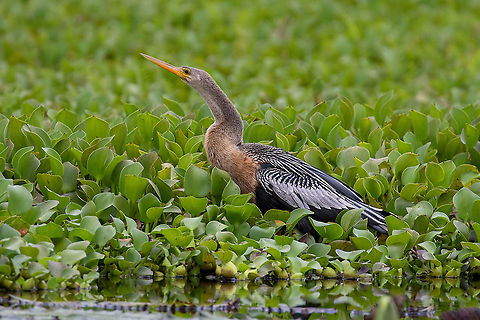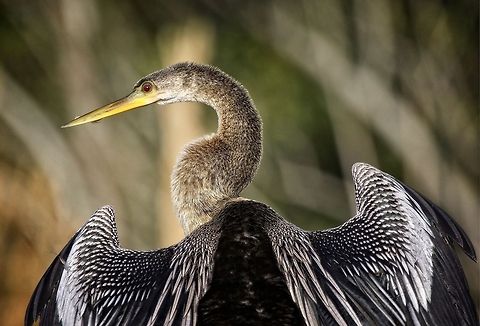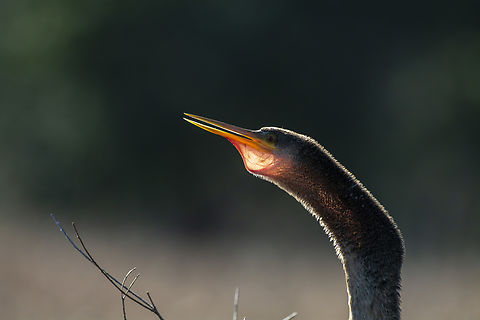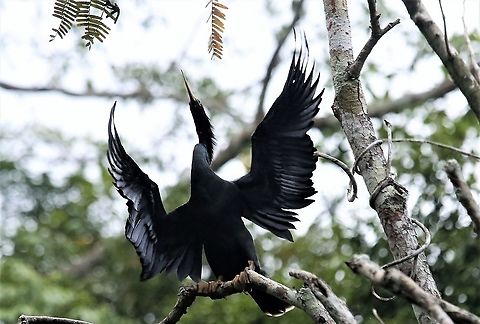
Appearance
The "A. anhinga" species is a large bird and measures approximately 89 cm in length with a 1.14 m wingspan. The "A. a. anhinga" is larger than "A. a. leucogaster" and has "broader buffy tail lips". They weigh 1.22 kg. The bill is long, sharply pointed and yellow as are the webbed feet.Most of the male Anhinga's body is a glossy black green with the wings, base of wings, and tail being a glossy black blue. The tip of the tail has white feathers. The back of the head and the neck have elongated feathers that have been described as gray or light purple white. The upper back of the body and wings is spotted or streaked with white.
The female Anhinga is similar to the male Anhinga except that it has a pale gray-buff or light brown head, neck, and upper chest. The lower chest or breast is a chestnut color and as compared to the male, the female has a more brown back.
The hatchling starts out bald but gains tan down within a few days of hatching. Within two weeks the tan down has been replaced by white down. Three weeks after hatching, the first juvenile feathers appear. Juveniles are mostly brown until first breeding after the second or third winter.
This bird is often mistaken for the Double-crested Cormorant due to its similar size and behavior. However, the two species can be differentiated by their tails and bills. The tail of the anhinga is wider and much longer than that of the cormorant. The bill of the anhinga is pointed, while the bill of the cormorant has a hook-tip.

Distribution
"Anhinga" species are found all over the world in warm shallow waters. The American Anhinga has been subdivided into two subspecies, "A. a. anhinga" and "A. a. leucogaster", based on their location. "A. a. anhinga" can be found mainly east of the Andes in South America and also the islands of Trinidad and Tobago. "A. a. leucogaster" can be found in the southern United States, Mexico, Cuba, and Grenada.Only birds that live in the extreme north and south of their range migrate and do so based on temperature and available sunlight. Anhingas will migrate towards the equator during winter but this range is "determined by the amount of sunshine to warm the chilled birds". Although not in their usual range, anhingas have been found as far north as the states of Pennsylvania and Wisconsin in the United States.
Kettles of anhingas often migrate with other birds and have been described as resembling black paper gliders.

Status
The Anhinga is protected in the US under the Migratory Bird Treaty Act of 1918....hieroglyph snipped... The number of individual anhingas has not been estimated but they are considered to be of least concern because of the frequency of their occurrence in their 15,000,000 km2 global range.
Migration
"Anhinga" species are found all over the world in warm shallow waters. The American Anhinga has been subdivided into two subspecies, "A. a. anhinga" and "A. a. leucogaster", based on their location. "A. a. anhinga" can be found mainly east of the Andes in South America and also the islands of Trinidad and Tobago. "A. a. leucogaster" can be found in the southern United States, Mexico, Cuba, and Grenada.Only birds that live in the extreme north and south of their range migrate and do so based on temperature and available sunlight. Anhingas will migrate towards the equator during winter but this range is "determined by the amount of sunshine to warm the chilled birds". Although not in their usual range, anhingas have been found as far north as the states of Pennsylvania and Wisconsin in the United States.
Kettles of anhingas often migrate with other birds and have been described as resembling black paper gliders.
References:
Some text fragments are auto parsed from Wikipedia.